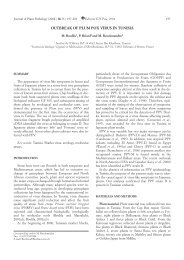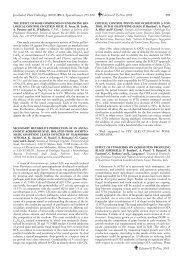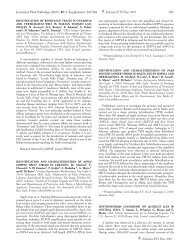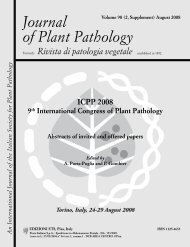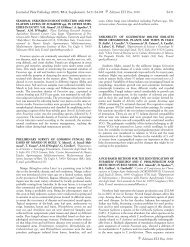CONTROL OF XANTHOMONAS CAMPESTRIS pv ... - Sipav.org
CONTROL OF XANTHOMONAS CAMPESTRIS pv ... - Sipav.org
CONTROL OF XANTHOMONAS CAMPESTRIS pv ... - Sipav.org
- No tags were found...
You also want an ePaper? Increase the reach of your titles
YUMPU automatically turns print PDFs into web optimized ePapers that Google loves.
Journal of Plant Pathology (2007), 89 (3), 361-367 Kotchoni et al. 365Fig. 4. Disease severity scored on infected seedlings treated atearly and late growth stages. Disease progression was scoredaccording to a severity scale in infected samples after seedlingtreatment. Chemical treatment was performed at primary leafformation stage (a) and at pre-flowering stage (b). Controlseedlings were treated with distilled water. Data representmean values (± SE) of three replicates experiments.grains/seed sterilisation for laboratory studies becausethey displayed a seed sterilization potential similar tothat of NaOCl (Table 1).Liao and Wells (1986) reported that X. campestris <strong>pv</strong>.vignicola is a pectolytic bacterium causing soft rot offruits and vegetables. ROS (H 2O 2) are able to induceplant cell wall modification, deposition of callose-containingpapillae, and production of hydroxyproline richglycoproteins, and phenolic compounds (Mazau andEsquerré-Tugayé, 1986; Aist and Bushnell, 1991) crucialfor disease resistance acquisition.Although we have shown that PCC and H 2O 2have adirect antibacterial effect on X. campestris <strong>pv</strong>. vignicola(Fig. 1), the mechanism(s) by which they reduce diseasein cowpea seedlings remains to be elucidated. To thebest of our knowledge, this study is the first report ofPCC being used in plant disease control. It is thereforesuggested that the possibile use of PCC on a wide rangeof crop species merits further investigations.of cowpea plants, indicating that PCC or H 2O 2treatmentswere able to alter also the expression patterns ofproteins that are presumably involved in defence responsemechanisms of the host cells.DISCUSSIONResults of the present study suggest that PCC andH 2O 2can be used under laboratory conditions to controlbacterial blight of cowpea caused by X. campestris<strong>pv</strong>. vignicola. We have shown that bacterial blight severitywas reduced when PCC and H 2O 2were used as seedtreatment as well as foliar spray under laboratory andgreenhouse conditions. PCC (Babalola, 1998) and H 2O 2(Peng and Kuc, 1992; Kotchoni et al., 2006) have alsobeen reported to exert antimicrobial activity on a widerange of micro<strong>org</strong>anisms, indicating their consistency ininterfering with the infection processes of thepathogens. Both chemicals and in particular H 2O 2arereadily available, easy to handle, and worth consideringfor disease management. H 2O 2is environmentallyfriendly and easily converted to water and oxygen in thepresence of light and atmospheric oxygen and is, therefore,harmless to the environment (Kotchoni and Gachomo,2006).Our findings show that PCC and H 2O 2can be usedas seed treatment to efficiently control seed-borne diseases.This is in agreement with the findings ofPernezny et al. (2002), where H 2O 2was used as seedtreatment to control black spot disease of lettuce leavescaused by X. campestris <strong>pv</strong>. vitians. We observed a synergiceffect of PCC and H 2O 2when used in combinationand found that PCC and H 2O 2can be used inFig. 5. Induction of NADH-peroxidase activity in cowpeaplants after chemical treatment. Measurements were fromcowpea plant samples treated with PCC, H 2O 2, PCC/H 2O 2at early growth (a) and flowering (b) stages. Samples werethen inoculated with the pathogen one-day post chemicaltreatment as described in material and methods. (-) = withoutchemical treatment: (+p) = PCC treatment; (+h) = H 2O 2treatment; (+ph) = PCC/H 2O 2treatment; (-I) = no bacterialinoculation; (+I) = bacterial inoculation. Data represent meanvalues (± SE) of three replicate experiments.



